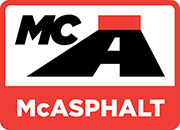Slurry Seals
Slurry seal is a mixture of aggregate, emulsified asphalt, water and additives that are properly proportioned, mixed and spread over a prepared surface. A polymer-modified system can be used in the same application and will enhance one or more properties of the slurry to better meet a particular project requirement. Slurry seal is applied in a single layer.
Design Criteria
When designing a slurry seal a number of factors have to be examined and assessed to ensure a proper surface will be placed that will perform for its service life. The following factors can have a tremendous effect on the performance of a slurry seal; traffic, aggregate shape, existing surface and compatibility. If these factors are addressed the chances of a good slurry seal being placed are greatly increased.
Traffic:
The type and quantity of traffic will have a large effect on the amount of asphalt emulsion to be used as well as the gradation of the aggregate.
Aggregate Shape:
The overall shape of the mix aggregate can influence the quantity of aggregate as well as the amount of asphalt emulsion to be used. The angularity of the aggregate will affect the performance of the finished seal.
Existing surface:
The texture and condition of the existing road surface will affect the aggregate type, quantity and emulsion rate.
Compatibility:
If these factors are taken into consideration in designing the slurry seal then the chances of a successful seal are greatly improved. By blending all the materials in the proper proportions a semi-fluid , homogeneous slurry will be produced.
Materials
Asphalt Emulsions:
A number of different types of asphalt emulsion can be used in slurry seals. The proper emulsion to be used has to be determined by running compatibility tests between the emulsion and the aggregate to be used. The most common emulsions used are SS-1h, CSS-1h, or CQS1-h with CQS1-h being the predominate one..
Mix Aggregate:
The type of mix aggregate used in slurry seals must meet certain requirements of shape, size, cleanliness and gradation. The asphalt emulsion to be used and the aggregate must be compatible to ensure the asphalt-aggregate bond is effective. There are three accepted gradations for the aggregate to meet;
- Type 1 – used on lower volume roads, parking areas or shoulders.
- Type 2 – most widely used gradation on moderate trafficked roads
- Type 3 – used on higher volume roads such arterial streets
Further information on the gradations can be found in the Basic Asphalt Emulsion Manual.
Mineral Fillers:
A small amount of additive may be added to the mixture to aid in controlling the break time and the setting of the slurry. Mineral fillers such as Portland cement, hydrated lime or fly ash may be added to aid in stabilizing and setting the slurry seal.
Water:
Water is used to aid in mixing and coating and controlling the consistency of the slurry seal. It should be potable and compatible with the mix.
Performance Guidelines
In order to construct a proper well designed slurry seal the following guidelines should be followed:
- Design a slurry seal with aggregate to be used on job
- Use a hard durable screenings
- Ensure compatibility of aggregate and emulsion
- Ensure a homogeneous condition of the mix
- Calibrate and inspect all equipment
- Follow proper construction techniques
- Use traffic control to protect seal
- Work only in weather suitable for placing slurry seal
